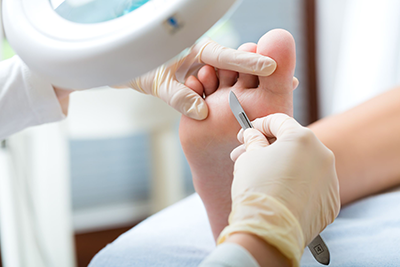Diabetic Foot CarePatient Education Videos
A diabetic foot is a foot that exhibits any pathology that results directly from diabetes mellitus or any long-term (or "chronic") complication of diabetes mellitus. Presence of several characteristic diabetic foot pathologies such as infection, diabetic foot ulcer and neuropathic osteoarthropathy is called diabetic foot syndrome. Due to the peripheral nerve dysfunction associated with diabetes (diabetic neuropathy), patients have a reduced ability to feel pain. This means that minor injuries may remain undiscovered for a long while. People with diabetes are also at risk of developing a diabetic foot ulcer. Research estimates that the lifetime incidence of foot ulcers within the diabetic community is around 15% and may become as high as 25%. In diabetes, peripheral nerve dysfunction can be combined with peripheral artery disease (PAD) causing poor blood circulation to the extremities (diabetic angiopathy). Around half of patients with a diabetic foot ulcer have co-existing PAD. Where wounds take a long time to heal, infection may set in and lower limb amputation may be necessary. Foot infection is the most common cause of non-traumatic amputation in people with diabetes. Two main types of diabetic foot:
The Neuropathic Foot Neuropathic foot develops ulceration at the sites of high mechanical pressure on the plantar surface. Neuropathic ulcers also result from thermal or chemical injuries that are unperceived by the patients because of loss of pain sensation. Neuropathy is associated with an 8- to 18-fold higher risk of ulceration and a 2- to 15- fold higher risk of amputation. The mechanisms through which neuropathy acts as a pathogenetic event for ulceration, and thus amputation, are complex and different. Above all, the reduction of protective sensitivity (including sensitivity to pain and heat) leads to a reduction in the perception of pain stimuli. Moreover, the motor component of neuropathy involves a progressive weakening of the intrinsic muscle component made up of interosseous and lumbrical muscles. It reveals itself as a deformation in toe flexion and the formation of overloaded plantar areas, identifiable from under the metatarsal heads and the tips of the toes. The autonomous component of neuropathy causes anhydrosis and dry, flaky skin, as well as an increase in arterio-venous shunting, leading to altered skin and bone perfusion. It has been widely demonstrated that a biomechanical foot alteration, which includes an increase in plantar pressures, bone abnormalities, mobility limitations, and equinus, is all linked to a significant increase in the risk of ulceration. The clinical characteristics of the neuropathic lesion are the development of an overloaded area surrounded by a callous formation before the development of the lesion, without painful symptoms. The risk of the lesion worsening in terms both of progressive deep tissue destruction and of infection is linked to the co-existence of an ischaemic component. Therefore, PVD must be excluded in the initial assessment of an ulcerated lesion, verifying that its clinical characteristics are proper to those of a neuropathic lesion. The literature clearly highlights how offloading is essential in cases of plantar neuropathic lesion. Simple offloading techniques are multifaceted and include casts and boots, sandals, half shoes, or felted foam dressings. The use of a non-removable cast has recently been shown to be faster treatment for plantar neuropathic ulcers than a half-shoe. The first step in treating an uncomplicated ulcerated neuropathic lesion is local debridement, dressing, and offloading. However, clinical conditions exist in which surgery becomes the treatment of choice. Indications for the surgical treatment of plantar neuropathic ulcers are essentially:
The neuroischaemic foot The neuroischaemic foot has both neuropathy and ischaemia. It develops ulcers on the margins of the foot and toes, often at sites of pressure from poorly fitted shoes. This pressure is unperceived because of a coexisting neuropathy. The main characteristic of PVD in diabetics is the morphological and clinical presentation.15 Painful symptoms are often reduced or absent due to the co-existence of neuropathic sensitivity, and medial arterial calcinosis is common. These features make PVD in diabetics more difficult to diagnose and therapy more problematic than in non-diabetics. They also mean that PVD plays a fundamental role in the prognosis of major amputation. Nevertheless, since the 1990s, revascularization procedures have been demonstrated to be feasible options, contrary to the initial thinking. Procedures ranging from distal revascularization to angioplasty and bypass interventions have all shown that they can change the original prognosis for amputation. Certainly, endoluminal or surgical revascularization is the only treatment capable of reducing the number of major amputations significantly. Revascularization can restore direct arterial flow where it has been interrupted or significantly reduced. This is an indispensable condition for healing a wound in an ischemic foot without resorting to amputation. Prevention
Prevention of diabetic foot may include optimising metabolic control (regulating glucose levels); identification and screening of people at high risk for diabetic foot ulceration; and patient education in order to promote foot self-examination and foot care knowledge. Patients would be taught routinely to inspect their feet for hyperkeratosis, fungal infection,skin lesions and foot deformities. Control of footwear is also important as repeated trauma from tight shoes can be a triggering factor. There is however only limited evidence that patient education has a long-term impact as a preventative measure. tch out their muscles. Treatment
Treatment of diabetic foot can be challenging and prolonged; it may include orthopaedic appliances, antimicrobial drugs and topical dressings. Most diabetic foot infections (DFIs) require treatment with systemic antibiotics. The choice of the initial antibiotic treatment depends on several factors such as the severity of the infection, whether the patient has received another antibiotic treatment for it, or whether the infection has been caused by a micro-organism that is known to be resistant to usual antibiotics (e.g. MRSA). The objective of antibiotic therapy is to stop the infection and ensure it does not spread. It is unclear whether any particular antibiotic is better than any another for curing infection or avoiding amputation. One trial suggested that ertapenem with or without vancomycin is more effective than tigecycline for resolving DFIs. It is also generally unclear whether different antibiotics are associated with more or fewer adverse effects. Treatment of infection There is increasing recognition of the importance and impact of diabetic foot infection in terms of both health-related quality-of-life issues and associated economic burden. Diabetic foot infections are one of the most common diabetes-related causes of hospitalization in the USA, accounting for 20% of all hospital admissions. Readmission rates for diabetic foot infection are ∼40% and nearly one of six patients dies within 1 year of the infection. Accordingly, prompt diagnosis and treatment of infection is crucial. Guidelines on the diagnosis and treatment of diabetic foot infection have been issued by the Infectious Diseases Society of America (IDSA). Cases of serious soft tissue destruction, osteomyelitis, and compartmental syndrome (progressive infection through plantar and dorsal compartments) are true medical and surgical emergencies. Infections of soft tissues, progressive compromise of deep tissues, and the development of osteomyelitic foci are the points which separate conservative treatment from a more aggressive surgical approach. This stage must include careful therapeutic planning, which should be based on microbiological examination after exclusion of the ischaemic component. Clearly revascularization must be postponed until after acute treatment of infection. Infections that do not pose an immediate threat of limb loss are defined as ‘non-limb-threatening’, and are generally characterized by the absence of signs of systemic intoxication. Infections defined as ‘limb-threatening’ show extended cellulitis, deep abscesses, osteomyelitis, or gangrene. Ischaemia characterizes a superficial lesion as limb-threatening. Acute infection (phlegmon, abscess, and necrotizing fasciitis) is an emergency condition that can threaten not only the limb but also the patient's life. It requires evaluation, and immediate hospitalization and treatment. The infection may be due to progressive destruction of soft tissues, or involvement of bone, and requires surgical treatment, and possibly amputation. The development of infection constitutes a foot care emergency, which requires referral to a specialized foot care team within 24 h. Surgical management of moderate-to-severe diabetic foot infection is often required and includes aggressive incision, drainage, and debridement of non-viable soft tissue and bone. Multiple debridements are often necessary to provide adequate drainage and control of infection. In many cases, rapid treatment is absolutely essential in effectively treating an acute wound in a diabetic foot. Recourse is often necessary to surgical treatment, carried out in emergency, without considering limiting factors such as metabolic compensation, or the patient's nutritional state or vascular condition. In this specific environment, surgical debridement presents advantages over other forms of debridement (enzymatic, physical, and chemical). In less urgent cases, patients can be treated in the ward or in bed, without need of anaesthesiological support. In cases of wider and deeper infections, an operating theatre is required for adequate debridement and drainage. This is especially so in cases with bone involvement. |
Additional Services |
Additional Conditions and Treatments
Book Your Appointment Today |









